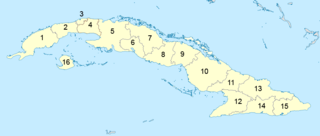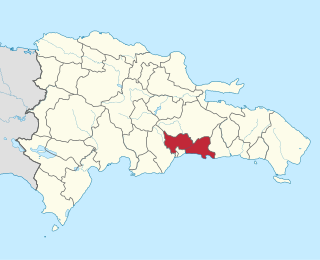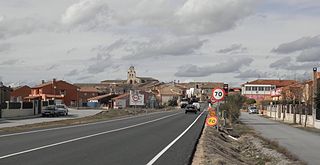
Murcia is a city in south-eastern Spain, the capital and most populous city of the autonomous community of the Region of Murcia, and the seventh largest city in the country. It has a population of 460,349 inhabitants in 2021. The total population of the metropolitan area is 672,773 in 2020, covering an urban area of 1,230.9 km2. It is located on the Segura River, in the southeast of the Iberian Peninsula. It has a climate with hot summers, mild winters, and relatively low precipitation.

Girona is a province of Spain, in the northeastern part of the autonomous community of Catalonia. It is bordered on the northwest by the province of Lleida, on the southwest by the province of Barcelona, on the north by France (Pyrénées-Orientales), and on the east by the Mediterranean Sea.

Toledo is a province of central Spain, in the western part of the autonomous community of Castile–La Mancha. It is bordered by the provinces of Madrid, Cuenca, Ciudad Real, Badajoz, Cáceres, and Ávila. Its capital is the city of Toledo.
The municipalities of Puerto Rico are the second-level administrative divisions in the Commonwealth of Puerto Rico. There are 78 such administrative divisions covering all 78 incorporated towns and cities. Each municipality is led by a mayor and divided into barrios, third-level administrative divisions, though the latter are not vested with any political authority. Every municipality is governed as stated by the Autonomous Municipalities Act of 1991, which establishes that every municipality must have an elected strong mayor with a municipal legislature as the form of government. Each legislature must be unicameral, with the number of members related to adequate representation of the total population of the municipality. In contrast to other jurisdictions, both the mayors and the municipal legislators are elected on the same date and for the same term of four years in office.

Elche is a city and municipality of Spain, belonging to the province of Alicante, in the Valencian Community. According to 2014 data, Elche has a population of 228,647 inhabitants, making it the third most populated municipality in the region and the 20th largest Spanish municipality. It is part of the comarca of Baix Vinalopó.

A province in Spain is a territorial division defined as a collection of municipalities, although their origin dates back to 1833 with a similar predecessor from 1822 and with roots in the Napoleonic division of Spain into 84 prefectures in 1810. In addition to their political function, provinces are commonly used today as geographical references for example to disambiguate small towns whose names occur frequently throughout Spain. There are many other groupings of municipalities that comprise the local government of Spain.

Administratively, Cuba is divided into 15 provinces and one special municipality. The last modification was approved in August 2010, splitting Havana province into two new provinces: Artemisa and Mayabeque. The new provinces started functioning from January 1, 2011. Havana City Province recovered its original name: La Habana.
La Antigua is a municipality in the Mexican state of Veracruz. The city of José Cardel serves as the municipal seat. La Antigua is regarded as the first real Spanish town in Mexico.

Vigo is a city and municipality in the province of Pontevedra, within the autonomous community of Galicia, Spain. Located in the northwest of the Iberian Peninsula, it sits on the southern shore of an inlet of the Atlantic Ocean, the Ria de Vigo, the southernmost of the Rías Baixas.

Santo Domingo is a province of the Dominican Republic. It was split from the Distrito Nacional on October 16, 2001.

Municipalities are the second-level administrative divisions of Mexico, where the first-level administrative division is the state. They should not be confused with cities or towns that may share the same name as they are distinct entities and do not share geographical boundaries. As of January 2021, there are 2,454 municipalities in Mexico, excluding the 16 boroughs of Mexico City.

A parroquia is a population entity or parish found in Galicia and Asturias in north-west Spain. They are entities with a territorial scope lower than municipality and have their own legal personality. They usually, but not always, coincide with the ecclesiastic divisions as they originated on pair with them.

The municipality is the basic local administrative division in Spain together with the province.

Arlanzón is a municipality and town located in the province of Burgos, Castile and León, Spain.

Sargentes de la Lora is a municipality located in the province of Burgos, Castile and León, Spain. According to the 2004 census (INE), the municipality has a population of 196 inhabitants.

Santa María la Real de Nieva is a municipality located in the province of Segovia, Castile and León, Spain, about 30 km (18 mi) northwest of Segovia town. According to the 2010 census (INE), the municipality had a population of 1,193 inhabitants.

La Nucia is a municipality in the comarca of Marina Baixa, Alicante, Valencian Community, Spain. It borders the municipalities of Altea, Callosa d'En Sarrià, Benidorm, Polop and L'Alfàs del Pi.

Arcos de la Llana is a Spanish town and municipality in the province of Burgos, Castilla la Vieja, in the autonomous community of Castilla y León (Spain), the region of Alfoz de Burgos, the judicial district of Burgos, and head of the city council of Arcos de la Llana.

Cartagena is a Spanish city and a major naval station on the Mediterranean coast, south-eastern Iberia. As of January 2018, it has a population of 218,943 inhabitants, being the region's second-largest municipality and the country's sixth-largest non-provincial-capital city. The metropolitan area of Cartagena, known as Campo de Cartagena, has a population of 409,586 inhabitants.



















